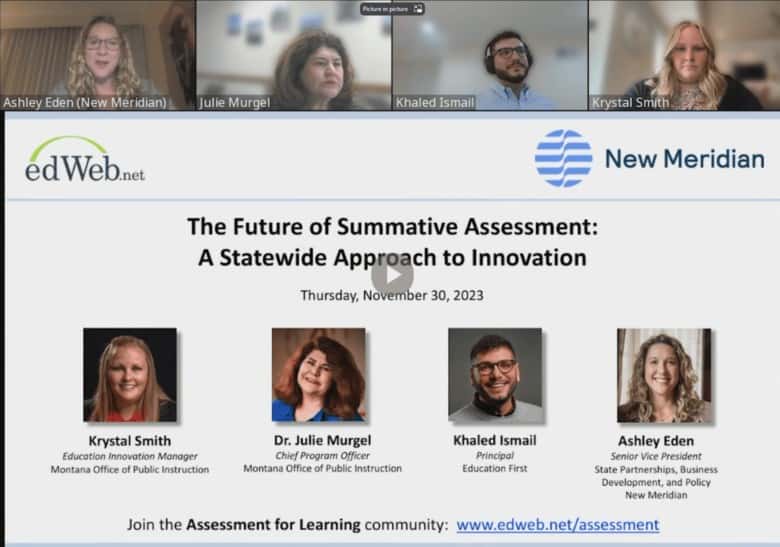A new report published by Bellwether Education Partners showcases “trailblazing states†that are making big, public reforms around innovation in state assessment. “States are continuing to rethink their roles in assessment and their assessment systems in ways that may benefit teaching, learning, transparency, and equity,†the report said.
Bellwether Education Partners, a nonprofit focused on improving education outcomes for underserved children, published the report to showcase innovative new approaches states are employing to get more value out of their largescale assessment systems and advance their equity agendas. Several trends noted in the report should interest state chiefs, assessment directors, and education policy leaders.
Shared Item Banks Increase Quality and Lower Costs
Developing assessments is expensive. Tests have dozens of items, each of which can cost thousands of dollars to develop, field test, and validate. While states once joined consortia to share costs, the lack of flexibility became problematic.
“Instead of sharing whole tests, more states now mix, match, and share large groups of items via shared item banks,†the report said, adding that this type of collaboration maximizes benefits and minimizes risks. “States face bigger risks going it alone,†the report said.
“Beyond cost-sharing benefits, this model is cause for optimism because it can support higher-quality tests and interstate collaboration,†the report said, adding that, “Shared item banks and hybrid test designs may also give states the ability to maintain stability and comparability in their scores over time, even if their tests change.â€
The report cites New Meridian’s work to foster sharing of content among states as an innovative new approach to increasing quality while reducing costs. New Meridian now manages a bank of more than 14,000 operationally ready test questions that have been developed by states and are available for licensing.
“States can license … that content from New Meridian for their own tests, along with options for various kinds of advisory and test development support,†the report said. “New Meridian’s approach [was] developed in direct response to states’ need for high-quality assessment content at a reasonable cost with autonomy around design decisions, especially among states leaving the consortia.â€
The conclusion: “States still have access to some of the advantages of a consortium (high-quality items at a reduced cost), and continuity in their test design and content, with the flexibility to make individual choices.â€
Science and Social Studies
Though the Every Student Succeeds Act (ESSA) requires a science assessment once in each grade band, there are no such requirements for social studies. Moreover, neither discipline is required to be tracked in state accountability systems, though some states do. Yet, the report concludes, having more flexibility for local design is enabling states to innovate in their approach to science and social studies assessments, and more opportunities lie ahead.
“Science and social studies assessments are ripe for state innovation and experimentation,†the report said. “These subjects could be a laboratory of assessment innovation, with wide flexibility in law and subject areas that have been somewhat neglected in the era of math and reading assessments.â€
Despite the lack of a federal requirement, 33 states offer a social studies assessment of some type. In science, 40 states have adopted new standards in the last five years. The adoption has been driven by the creation of two national standards, including the Framework for K–12 Science Education created by the National Research Council (used in 21 states) and the Next Generation Science Standards created by a group that included the National Academies of Science (used in 19 states).
Several states are leading the way in innovative science and social studies assessment design. Louisiana has created a pilot program that mixes social studies and English language arts in a single assessment. New Hampshire combines classroom-based performance assessments in science in most grades with a single statewide summative assessment in grade five and high school.
“Science and social studies content are both especially well-suited to performance-based, hands-on activities and tasks, which can be engaging for students and provide deeper information on learning to teachers,†the report said.
Interim and Formative Assessment
The report also highlighted efforts to augment summative testing with interim testing, which administers assessments in a more compressed time frame to provide more timely feedback, and formative assessment, administered as instruction and learning take place.
Both strategies can impact instruction more frequently and more quickly, and the renewed interest in adding interim and formative components can bring balance to state assessments. Companies like New Meridian are working with states to formulate such plans, and several states have made major strides.
“Whereas once the state role in assessment was almost entirely limited to developing and administering traditional summative tests, states are thinking about ways to build more comprehensive assessment systems that include different kinds of tests and align with parallel efforts to improve instruction, professional development, standards, and curriculum,†the report said.


